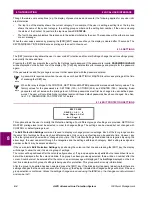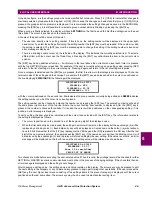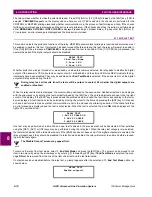
8-14
ALPS Advanced Line Protection System
GE Power Management
8.1 INTRODUCTION
8 LOCAL USER INTERFACE
8
If the second choice, Uploaded data, is selected, a check is made to verify whether any uploaded oscillography data exists
in the relay. If the data does not exist, an error message is displayed. If the data exists, the user is asked to select the set-
tings to be used during playback, as explained for the item Factory test case. An oscillography file may be uploaded by
using LPSO-Link (refer to Chapter 11 ALPS-LINK USER GUIDE). The playback is started after all prompts are answered.
The word ON will be displayed as long as playback lasts.
The only data files that can be uploaded to the relay are
OSC
files downloaded from another LPS-O, LPS-D, or ALPS model
relay, or a binary or ASCII Commtrade file from another source (Commtrade details are explained below). These files con-
tain the analog data, flags and settings to be uploaded to the relay.
Any file that meets the Commtrade format may be downloaded to the relay after it has been converted to
OSC
format using
the
CTRD2OSC.exe
program provided with the ALPS software suite. It will be installed into the same directory as ALPS-
Link. This utility converts only the analog data from the file; all flag values are set to 0, and default settings will be added to
the file. View the
CTRD2OSC.TXT
text file for complete instructions on using the conversion utility. The only data used from
a Commtrade file is the analog channel data. All other data are discarded and replaced with dummy values. The data must
be sampled at a rate of 64 samples per power cycle or 3840 samples/second at 60 Hz.
The values of the oscillography setting are obtained from the current settings, not the ones in the playback fault. Therefore,
the new fault report will correspond to the current settings. For example, if the playback fault has 36 cycles of data, but the
current NUMFAULT is set to 8, only 18 cycles of data will appear in the new fault report. Conversely, if the playback fault
has only 12 cycles of data and the current setting will generate 36 cycles, then 24 cycles of zero data will be processed at
the end of playback.
If the third choice, Data in relay, is selected, the user is asked to select the settings (current/fault) for playback. After the
settings have been selected, the summary of faults to be selected is displayed. If fault settings is selected, the settings
active at the time of the fault will be used. The settings file is attached to the oscillography and is always saved with the
oscillography data.
The cursor will be located on the second line. To move cursor to an item, use the arrow keys or enter the fault number fol-
lowed by the [ENT] key. If entering a number, the digits pressed are echoed at the top right corner of the display. Pressing
the [ENT] key after moving the cursor to the desired item starts playback. The top line changes to indicate that playback
has started. The word ON will be removed from the display as soon as the playback is complete.
Two checks are made before starting playback: the privilege level must be MASTER and communications must not be in
the process of performing an action. If either of these checks fails, an error message is displayed to the user and the test is
canceled.
If End Playback is chosen and the outputs are disabled, the relay prompts with the dialogue:
If YES is chosen, the outputs are enabled, the status LED turns GREEN (if playback test was the only reason to turn it
RED), and the ACT command category selection is displayed. If NO is chosen, the outputs remain disabled, the Status
LED remains RED, and the ACT command category selection is displayed.
8.1.21 CHANGE PASSWORD
This category is used to change the SETTINGS, CONTROL and MASTER passwords. The arrow keys may be used to
scroll to the desired item. To select an item press the [ENT] key. Once a password has been selected to be changed, only
the number keys can be used to enter the old password. The digits are echoed with an asterisk (*) for privacy. When the
[ENT] key is pressed, the old password is checked for validity. If the password is valid, the relay will prompt for the new
password.
Only the number keys can be used to enter the new password. Once the new password has been entered, the relay will
prompt to re-enter the new password to ensure no mistakes were made while typing.
If the two password entries are identical then PASSWD CHANGED is displayed and the new password replaces the old
one. Otherwise, PASSWD NOT CHANGED is displayed and the password is not changed.
No privilege level is needed to use this command and communications is not checked.
Enable Outputs?













































